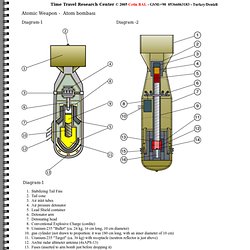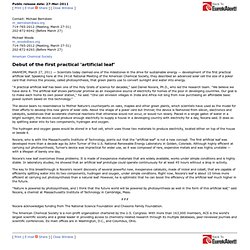

Atomic Weapon. Time Travel Research Center © 2005 Cetin BAL - GSM:+90 05366063183 - Turkey/Denizli Atomic Weapon - Atom bombası Diagram-1 Diagram -2 Diagram-1 Stabilizing Tail Fins Tail cone Air inlet tubes Air pressure detonator Lead Shield container Detonator arm Detonating head Conventional Explosive Charge (cordite) Uranium-235 "Bullet" (ca. 24 kg, 16 cm long, 10 cm diameter) gun cylinder (not drawn to proportion: it was 180 cm long, with an inner diameter of 10 cm) Uranium-235 "Target" (ca. 36 kg) with receptacle (neutron reflector is just above) Archie radar altimeter antenna (4xAPS-13) Fuses (inserted to arm bomb just before dropping it) Diagram-2 The Fat Man atomic bomb being readied on Tinian The initial design for the plutonium bomb was also based on using a simple gun design (known as the "Thin Man") like the uranium bomb.

Fat Man Specifications Interior of the Fatman bomb. Hubbard's comments on the bogeyman of the time - the atomic bomb - are unintentionally hilarious. Fusion. BioPower Systems. Turn Steel Into Solar Panels With Photovoltaic Spray Paint. No, it's not a joke or a crazy awesome futuristic concept . It's real. Tata Steel Europe (formerly Corus) and Swansea University in Wales, UK are collaborating to develop a spray-on technology that would transform steel sheets into solar panels. Earth and Industry says , The technology has significant applications since it is highly efficient even in diffused sunlight. Therefore, countries at higher latitudes or those with limited solar energy resource can generate significant amounts of solar-powered electricity with going for large-scale power plants.
If extended, the technology can find its way to the automobile industry where photo-sensitive dyes can be applied to cars to generate electricity to split water into hydrogen and oxygen for fuel cells. Imagine the applications of such a product. The power options could be limitless. And if you think the spray-on solar technology is years away from reality, think again. [Photo: Jaredmoo /Flickr] Scientists Develop Affordable Solar Panels That Work In The Dark. It's about damn time, don't you think?

Scientists at Lawrence Berkeley National Laboratory announced Wednesday that they have been able to confirm a new high-efficiency solar cell design that utilizes nearly the entire solar spectrum. Translation: They figured out a way to make solar panels generate electricity in the dark. CleanTechnica says , In earlier trials, the researchers used different alloys that achieved full spectrum responses but involved very high production costs. The advantage of gallium arsenide nitride is that it is very similar to a conventional semiconductor, gallium arsenide, and it can be produced with a commonly used fabrication method involving chemical vapor deposition. The Lawrence Berkeley breakthrough represents just one path to increasing the efficiency and lowering the cost of solar cells. In the meantime, you could just turn any metal surface into solar panels with photovoltaic spray paint .
[Photo: Norby /Flickr] Wind Power Without the Blades: Big Pics. Magenn Power Inc. Ideas - TREEFINDER. My subversive attempts to do something useful.

The Rotary Piston Array Machine -- Air-Sea Temperature Difference Engine -- Solarthermal Power Generator The Rotary Stirling Engine The Wave Pump Heat Engine With No Compressor Portable Tent Platform The rotary piston array (RPA) is the possibly most compact and most elegant machine to transform the volumetric change of gas into shaft work and vice versa. It can be used as pneumatic motor, steam engine, gas compressor, vacuum pump and the like, but also as part of new heat or combustion engines which – like the Stirling engine – open new ways to harvest renewable energy. Other possible uses are refrigeration and air-conditioning.
The idea has been overlooked for at least 110 years, as some old patents indicate, and it seems to have been reinvented several times (e.g. The machine comprises an array of equally shaped twisted rotors with parallel axes. Debut of the first practical 'artificial leaf' Public release date: 27-Mar-2011 [ Print | E-mail Share ] [ Close Window ] Contact: Michael Bernstein m_bernstein@acs.org 714-765-2012 (Meeting, March 27-31) 202-872-6042 (Before March 27) Michael Woods m_woods@acs.org 714-765-2012 (Meeting, March 27-31) 202-872-6293 (Before March 27) American Chemical Society ANAHEIM, March 27, 2011 — Scientists today claimed one of the milestones in the drive for sustainable energy — development of the first practical artificial leaf.

"A practical artificial leaf has been one of the Holy Grails of science for decades," said Daniel Nocera, Ph.D., who led the research team. The device bears no resemblance to Mother Nature's counterparts on oaks, maples and other green plants, which scientists have used as the model for their efforts to develop this new genre of solar cells.
The hydrogen and oxygen gases would be stored in a fuel cell, which uses those two materials to produce electricity, located either on top of the house or beside it. Renewable Energy.